Call me weird, but I absolutely love the planning stage of any trip! Planning a trip is like embarking on a thrilling journey before the actual adventure even begins. The further I delve into trip planning, the more my sense of anticipation builds. By the time departure day arrives, I am bursting with excitement! I am also completely confident that I have left no stone unturned in the planning process. Yes, of course, things can go wrong. Plans may need to change, but that’s perfectly fine. I am aware of potential pitfalls and have even considered alternatives should they arise. It’s not just about booking flights and packing bags; it’s about crafting an experience that will leave a lasting impression on your soul. Whether it’s a quick weekend escape or a long vacation abroad, a well-thought-out travel plan is essential for ensuring a smooth and enjoyable journey.
Keep reading for my comprehensive guide to planning your next trip.
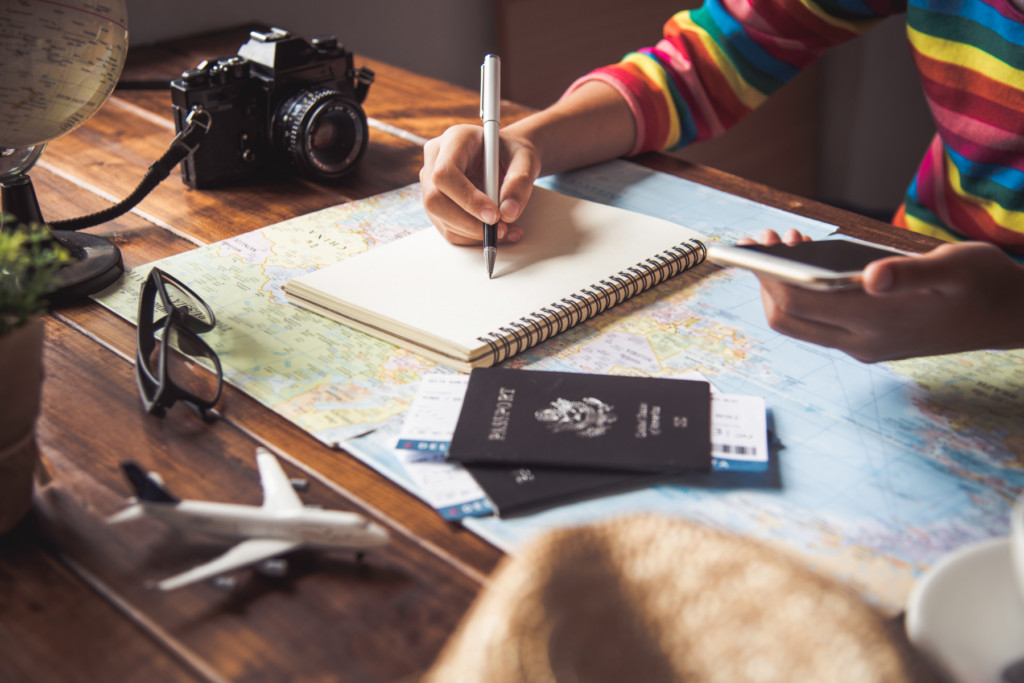 Person making trip notes surrounded by travel items like a world map, passports, and camera
Person making trip notes surrounded by travel items like a world map, passports, and camera
First Thoughts on Trip Planning
1. Planning Isn’t For Everyone, and That’s Okay
And that’s perfectly alright! Mark is definitely not a planner. This is likely because he knows I enjoy it 😊. However, he prefers not to know my plans in advance. He’d rather I tell him what’s happening just a day or two before (or even on the morning!). He enjoys the element of surprise. He appreciates that I’ve done all the research about our destination and can share information at the perfect moment. This approach wouldn’t work for me at all! I believe this difference is one of the reasons why we travel so well together!
If you identify more with Mark, but don’t have someone like me to handle the planning, don’t worry! I still suggest having a basic travel plan, even if it’s just to ensure you don’t find yourself stranded without resources. But, and here’s the good news – there are numerous resources available to assist you.
Whether you are a Mark or an Andrea when it comes to trip planning, this guide is designed to help you😊.
 Person holding a phone and looking at a laptop while taking notes about travel planning
Person holding a phone and looking at a laptop while taking notes about travel planning
2. Don’t Overplan Your Getaway
As much as I love meticulously planning our trips, I understand the importance of flexibility. Sometimes, things don’t go as expected.
- Flights can be cancelled.
- Political situations in a country can change suddenly.
- Weather can disrupt even the most carefully made plans.
- Unexpected opportunities might arise.
- You might meet someone who suggests an activity you hadn’t considered.
- You might receive an invitation to a local event. This has happened to us numerous times, notably when we were invited to a wedding during our trip around Ethiopia.
You shouldn’t miss out on these unique, once-in-a-lifetime experiences simply because you decided months ago to visit a particular monument on that specific day! If you overplan, you might even find yourself too exhausted. Instead of attending that pre-booked and paid-for guided tour, you might prefer to spend a relaxing day on the beach with a good book and a cocktail or two.
So, when you’re planning any trip, remember to incorporate some downtime. Give yourself choices for activities and dining, rather than strictly adhering to a rigid itinerary. Be adaptable. Be open to surprises. Some of your most cherished travel memories will stem from unplanned adventures.
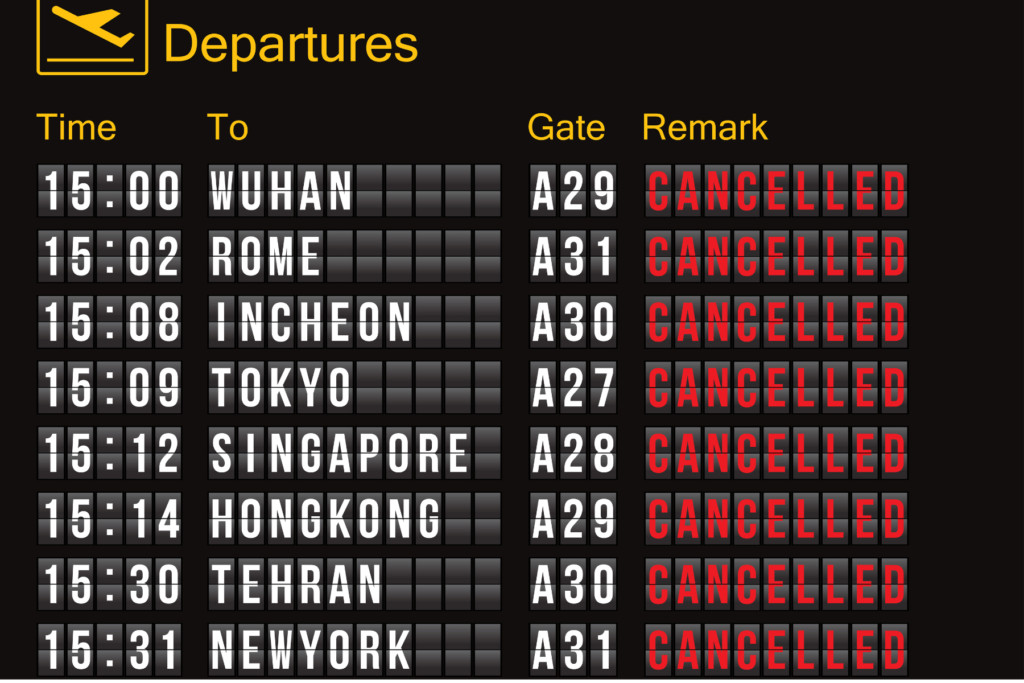 Airport departure board displaying numerous cancelled flights to destinations like New York and Singapore
Airport departure board displaying numerous cancelled flights to destinations like New York and Singapore
3. Planning Shouldn’t Feel Overwhelming
Trip planning can feel incredibly daunting, especially if it’s your first time. There’s a vast amount of information available, and it’s difficult to know where to begin. Once you start, it’s easy to feel overwhelmed, get sidetracked, or both. That’s why staying focused is key. Follow my step-by-step guide to planning your next trip. I’ve developed it over years of traveling to every corner of the globe. It’s effective for any trip, regardless of length or type.
4. Decide How You’ll Keep Track of Your Plan
By the end of the trip planning process, you’ll have a substantial document containing all the essential information for your trip – from accommodation and transportation details to must-try foods and attractions. You’ll need to carry this document with you and refer to it frequently during your travels. Therefore, deciding on the format of this document before you start is important. Do you prefer a digital format on your phone? If so, consider downloading one of the many free trip-planning apps available. Or are you more traditional like me and prefer a physical written plan filled with notes and annotations that you can easily flip through? If so, choosing a suitable notebook is your first enjoyable task in the trip planning process.
 A5 black notebook with ribbon markers and pens, representing a traditional travel planning method
A5 black notebook with ribbon markers and pens, representing a traditional travel planning method
Trip Planning: A Step-by-Step Guide
Now we are ready to begin. Let’s take it one step at a time.
Step 1: Check Your Passport Validity
It might seem unusual to make this the first step in planning your trip, but if you’re traveling internationally, trust me, it’s crucial! Why?
- It might not have sufficient remaining validity. Many countries require that your passport be valid for at least six months beyond your intended stay. I recently heard of travelers who were caught out by this rule because their passports were issued approximately 10 years prior. Even though the expiry date was still more than 6 months away, the passport control officer noted the issue date rather than the expiry date. For instance, in the UK, you can renew your passport at any time, and any extra months are added to the new passport’s validity. My current passport was issued in June 2015 but expires in January 2026. Therefore, I will renew it before our trip in October 2024 😊.
- You might not have enough blank pages left. Check the specific requirements for each country you plan to visit. Our recent seven-month trip to 13 African countries used up a surprising number of pages!
- Your passport might contain stamps from countries that are not favored by your next destination. For example, visitors to the USA might not be eligible for an eVisa if they have traveled to Cuba recently. Travelers with Israeli stamps in their passports might be denied entry to some Middle Eastern countries. Even novelty stamps from tourist sites can invalidate your passport. In 2020, a woman was denied boarding a flight from Madrid to Thailand because of a Machu Picchu stamp, which Qatar Airways deemed to have invalidated her passport.
- Your passport could be damaged or worn. Some passport authorities may refuse entry if your travel documents are not in good condition.
- The processing time for a new passport might be longer than you expect. Currently in the UK, passport renewals are taking around 10 weeks.
- You might need to send your passport away with a visa application. With the rise of eVisas, this is less common than it used to be, but some countries still require you to apply in person at a consulate or embassy to have a visa affixed to your passport.
So, the key message is – sort out your passport situation first, before moving on to any other trip planning steps!
 New UK passport after Brexit, emphasizing passport validity for travel planning
New UK passport after Brexit, emphasizing passport validity for travel planning
Step 2: Choose Your Destination
You might already have a specific destination in mind for your next trip. Perhaps you’ve been dreaming about it for a long time and now you just need to plan the details. Or maybe you’re undecided about where to go. You might be like me and have an extensive bucket list, making prioritization essential. In this case, your decision will be influenced by factors like:
- Cost
- Available time
- Season
- Ease of travel within the destination – something we increasingly consider as we get older. We are planning to undertake more challenging trips (South America, northern India, the Stans, etc.) before ‘easier’ ones (Australasia, Europe, North America, etc.).
If you’re truly unsure of where you’d like to go, start by asking yourself some questions:
- What kind of experience am I seeking?
- Am I looking for relaxation or adventure? Or a mix of both?
- Do I prefer a city break or a beach vacation?
- Am I interested in more adventurous activities like overlanding or hiking?
- Would I prefer to travel solo, with a partner, or in a group?
- What’s my ideal weather for the trip?
- What’s my budget for this trip?
- How long should the trip be?
- What are my must-have elements for the trip? Culture? Music? History? Nature? Hiking? Beaches? Sports? High-adrenaline activities? Good food? Nightlife?
- How do I want to travel? By air? By sea? Overland? Cycling? Walking? Self-drive? Train?
Once you’ve determined the type of trip you’re looking for, browse online. Open-minded searching can reveal options you might never have considered. It’s truly exciting! Find destinations that align with your preferences and choose the one that appeals to you most.
With your destination chosen, you have a clear goal and are ready for step three.
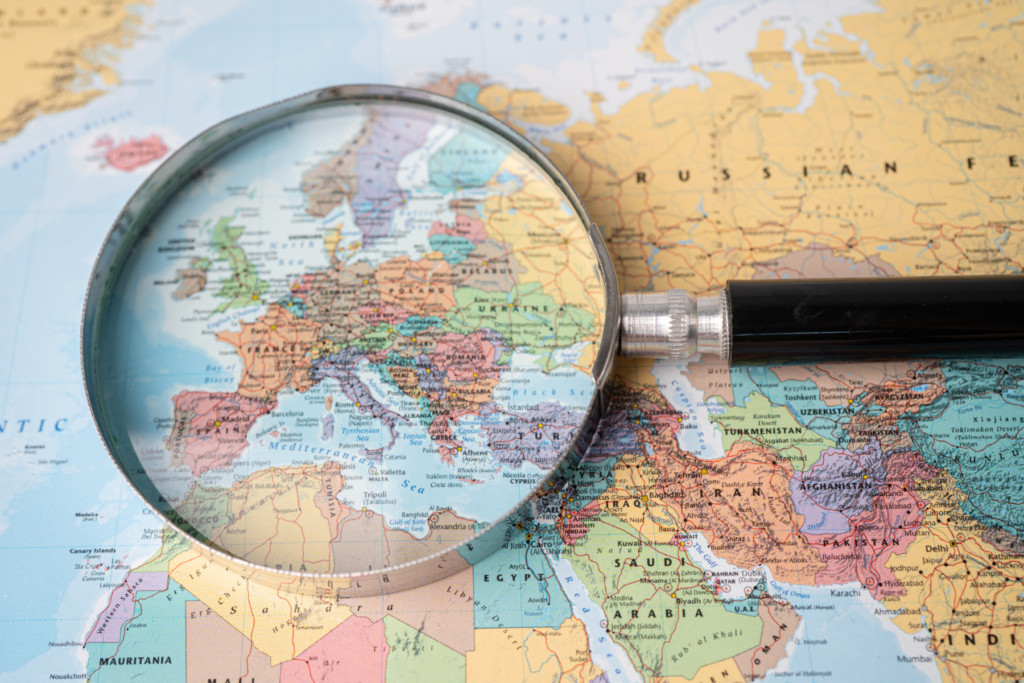 World map with a magnifying glass over Europe, symbolizing destination research for travel planning
World map with a magnifying glass over Europe, symbolizing destination research for travel planning
Step 3: Research Your Destination Thoroughly
Begin by using a search engine like Google to learn more about your chosen destination. Discover essential factual information, but also explore independent websites such as mine for more personal insights, including tips on must-see sights, local foods to try, and hidden gems. Read articles and blogs offering firsthand accounts of travel in your chosen areas.
Key research areas:
- Location: Use Google Maps to pinpoint your destination. Consider neighboring countries or cities that could be added to your itinerary.
- Language: What language is spoken?
- Currency: What currency is used?
- Passport/Visa Requirements: What are the entry requirements?
- Climate: What is the climate like? What’s the best time to visit?
- Religion: What is the predominant religion?
- Festivals and Holidays: Are there any local events you’d like to experience?
- Cost of Living: What are the average daily expenses?
- Safety: Are there any specific safety concerns?
- Political Situation: What is the current political climate?
- Vaccinations: What vaccinations are recommended or required?
- Malaria: Is malaria prevention necessary?
- Attractions: What are the must-see attractions?
- Food and Drink: What local foods and drinks should you try?
In the UK, my first stop for practical information and up-to-date travel advice is the UK government website – https://www.gov.uk/foreign-travel-advice. Look for the equivalent resource in your country.
 Tablet showing Google search engine, representing online destination research for trip planning
Tablet showing Google search engine, representing online destination research for trip planning
Step 4: Establish Your Travel Budget
Decide on your budget for the trip.
During your destination research, you will have gathered information about the cost of living. Searching Google for “average cost of a stay in ______________” will provide numerous results giving you a good estimate of expenses, whether you are a budget-conscious or luxury traveler.
Regardless of your destination, you’ll have four main expense categories:
- Transportation
- Accommodation
- Activities and Sightseeing
- Food
Aim for flexibility in your budget allocation. Set aside a reasonable amount for flights, but avoid spending all your funds on airfare if it means missing out on essential experiences at your destination. If you’re exploring a larger region, consider bus and train travel as alternatives to domestic flights. These options are often more economical and offer a more authentic travel experience. Don’t overspend on lodging. Focus on clean and comfortable accommodations, recognizing it’s primarily a place to sleep. Allocate funds for dining out, but if you’re on a tighter budget, look into self-catering options to prepare some meals yourself. This also gives you the opportunity to shop at local markets!
Don’t forget to budget for travel insurance. The cost will depend on:
- Destination (insurance is generally pricier for trips to the USA or the Caribbean).
- Trip duration.
- Travel companions.
- Age.
- Pre-existing health conditions.
- Value of equipment you are taking.
- Participation in adventure activities like scuba diving or skiing.
Crucially, don’t allocate your entire budget. Always keep a financial cushion for unexpected situations!
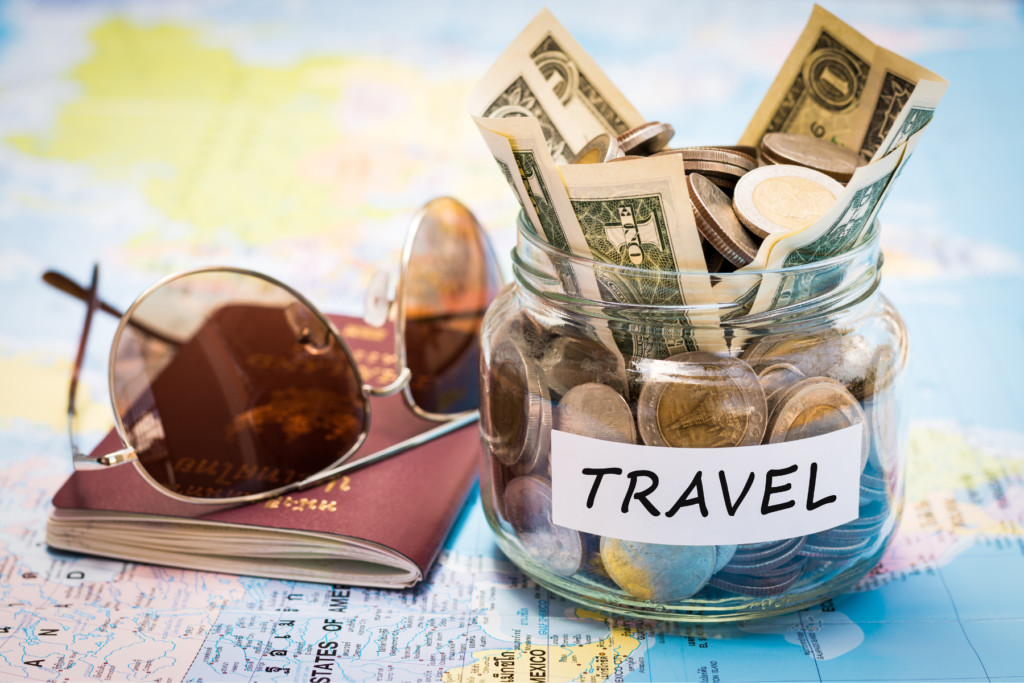 Jar filled with cash on a world map with passport and sunglasses, illustrating travel savings for trip planning
Jar filled with cash on a world map with passport and sunglasses, illustrating travel savings for trip planning
Step 5: Select Your Travel Dates
Now that you know your destination and budget, the next step is to decide when to travel. Choose dates based on:
- Your availability
- Preferred season
- Destination’s climate
- Local events or festivals you wish to attend. This is important – you don’t want to arrive just after a major event! My current South America trip planning is centered around being in Rio de Janeiro for Carnival and my 60th birthday! We have six months of travel to get there, but our arrival date in Brazil is non-negotiable! 😊
Before finalizing your dates, check for any travel advisories or restrictions that might affect your trip.
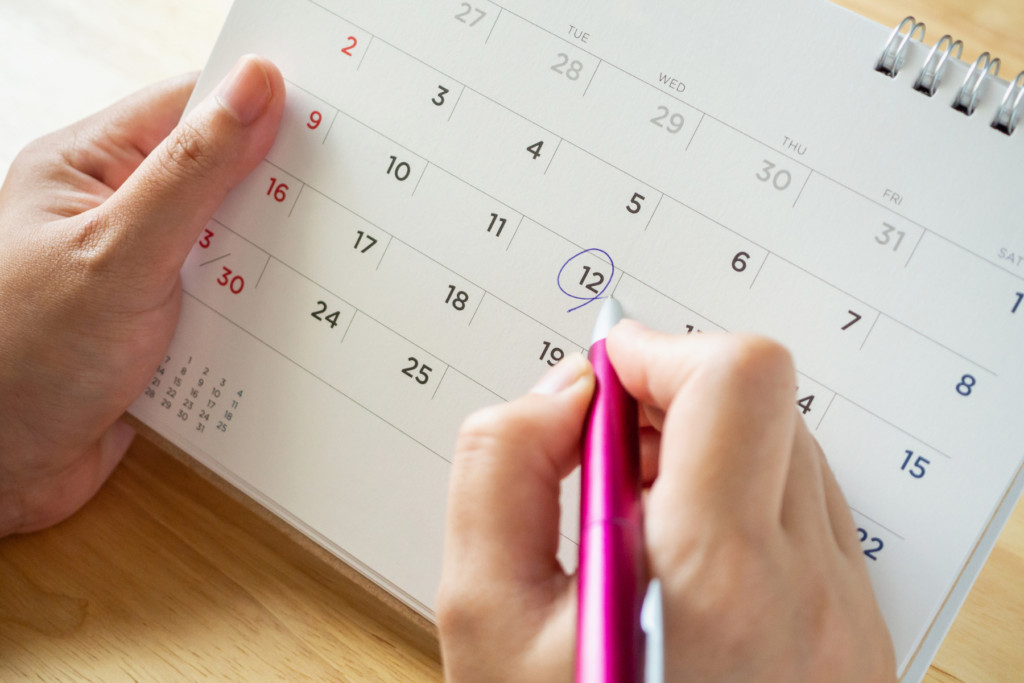 Person circling dates on a calendar, representing travel date selection for trip planning
Person circling dates on a calendar, representing travel date selection for trip planning
Step 6: Secure Travel Insurance Early
Again, it might seem early in the trip planning stage to think about travel insurance, but it’s not. Thoroughly research the best travel insurance to suit your needs. Don’t just choose the cheapest option. Ensure it covers the type of trip you’re taking and provides sufficient coverage for valuables and medical emergencies.
Purchase travel insurance before you start paying for trip components like flights and accommodations. This offers peace of mind should anything happen between booking and departure.
Consider using a credit card for flights and other major expenses, as many include travel insurance.
If you have an annual travel insurance policy, verify that it covers your specific trip. Some annual policies have restrictions on trip length or exclude certain destinations.
Most importantly, NEVER travel without insurance! We’ve all heard stories about uninsured travelers facing huge costs. One story that comes to mind is a young solo female traveler we met in Tobago. She declined travel insurance due to cost but unfortunately became ill. Local medical facilities couldn’t treat her, requiring a costly medical evacuation to Miami, Florida.
Don’t make the same mistake!
Step 7: Understand Visa Requirements
Visa processes vary by nationality and destination. While many countries now offer eVisas or visas on arrival, some still require applications in your home country, possibly involving embassy visits or postal applications.
Start by researching the specific visa requirements for your destination on official government and embassy websites. Application processing times can range from days to weeks, so apply well in advance. Prepare necessary documents like passport validity proof, accommodation confirmation, return flight tickets, and evidence of financial stability. For example, for Thailand, ensure your passport is valid for at least six months and remember to complete the arrival card on your flight.
Some visas on arrival require cash payment, often in USD. Don’t assume card payments are accepted.
Ensure you apply for the correct visa type. Do you need a single-entry visa, or a multiple-entry visa if you plan to leave and re-enter the country? If you plan to volunteer, a tourist visa may not be sufficient.
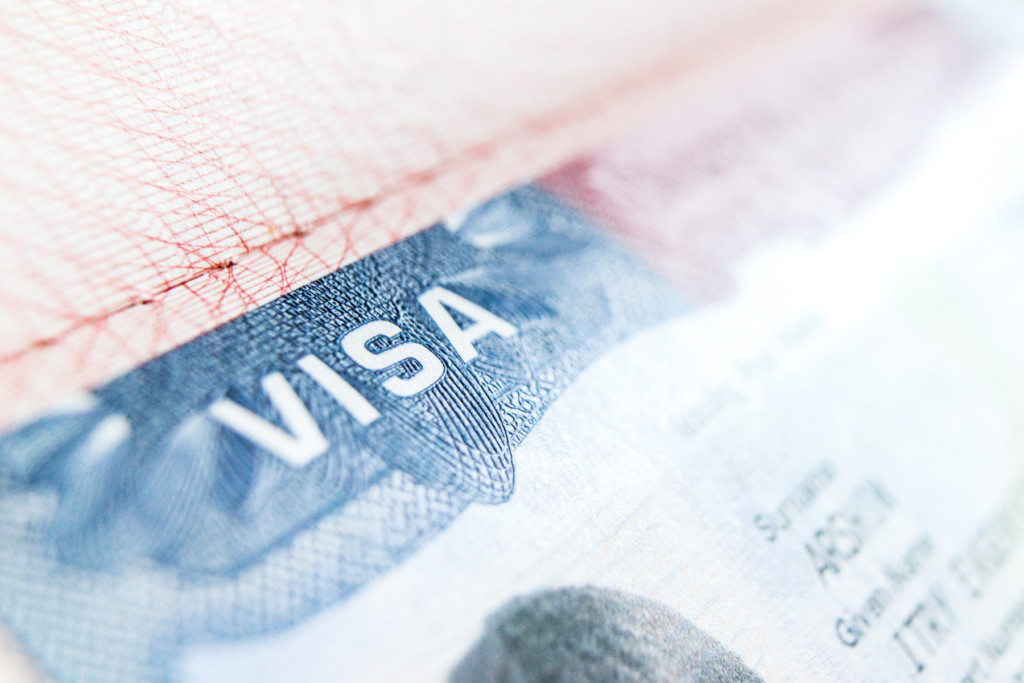 Visa stamp in a passport, emphasizing visa requirements for international travel planning
Visa stamp in a passport, emphasizing visa requirements for international travel planning
Step 8: Determine Necessary Vaccinations
When planning any trip, especially internationally, consider necessary vaccinations to protect your health. Research online to find out what’s recommended or required for your destination. In the UK, a primary resource is this government-backed travel health website. Find a similar resource in your home country.
Visit a travel clinic or healthcare provider 6-8 weeks before departure. This allows vaccines enough time to become effective. Some vaccines may have mild side effects like soreness or a low fever, which are normal and temporary. Vaccination protects your health and contributes to safer travel for everyone.
Don’t skip vaccinations due to cost. Include it in your budget. If you can’t afford necessary precautions, consider a different destination. Before our seven-month African trip, we faced a £750 bill to update expired vaccinations!
 Person getting travel vaccinations, highlighting health preparations for trip planning
Person getting travel vaccinations, highlighting health preparations for trip planning
Step 9: Book Your Transportation
Whether flying, driving, or taking a train, booking some transportation in advance is advisable.
 Airplane taking off, symbolizing transportation booking in travel planning
Airplane taking off, symbolizing transportation booking in travel planning
Transportation is key to shaping travel experiences. From flights to trains and buses, choices are as varied as destinations. Consider ticket prices, schedules, and comfort. Trains and buses offer chances to interact with locals and embrace spontaneity. Flights or private transfers offer convenience.
For flights, Skyscanner is my first stop for deals. I often find cheaper prices on Skyscanner than directly on airline websites. My Skyscanner tips:
- Start searching early.
- Be flexible with dates for better prices.
- Set up email alerts for price drops.
- Don’t just book the cheapest flight.
- Check times – early or late flights might require extra hotel nights.
- Check luggage allowance.
- Understand cancellation/amendment policies.
- Decide if seat selection is worth the extra cost. Checking in early usually allows seat choice anyway.
- Use the ‘everywhere’ function on Skyscanner for destination flexibility or to find alternative routes. For example, to get to Johannesburg, flying via Seychelles was cheaper than a direct flight from London!
Booking transportation early secures your spot and ensures smoother travel.
Step 10: Choose and Book Your Accommodation
Accommodation is often the most time-consuming part of travel planning. It’s just a place to sleep, but I want to choose well. Consider what’s important to you.
Accommodation factors:
- Cost – stick to your budget.
- Location – central locations might save on transport costs.
- Type – luxury hotel, budget-friendly, boutique, hostel, self-catering?
- Deals – free breakfast, multi-night discounts?
- Amenities – Wi-Fi, pool, gym, airport transfer?
- Reviews – check customer feedback but don’t over-analyze minor complaints.
Book early, especially for peak seasons. Balance comfort, location, and price.
For booking, I prefer Booking.com for its easy navigation, favorite lists, Genius Rewards program, fair cancellation policies, and wide range of options.
 Resort pool with sun loungers, representing accommodation booking in travel planning
Resort pool with sun loungers, representing accommodation booking in travel planning
Step 11: Plan Your Activities and Excursions
With the essentials booked, plan your activities. This is my favorite part! Research attractions and activities using search engines or guidebooks. Choose based on your interests, time, and budget. Don’t just follow popularity; align with your preferences.
Consider logistics like transportation and opening times. Look for city passes that combine travel and attraction entries for cost savings.
Decide between guided tours or independent exploration. Local guides offer invaluable insights. Walking tours upon arrival in a new city are great for orientation and local tips.
Get Your Guide and Viator are great for finding and booking activities.
 Person hiking through a forest, symbolizing activity planning in travel planning
Person hiking through a forest, symbolizing activity planning in travel planning
Allocate time wisely. Pre-book activities to save time and sometimes money, but don’t overschedule. Allow time to enjoy each activity and for spontaneous exploration.
Step 12: Pack Efficiently and Smart
Organize packing well before departure. Choose luggage and make a packing list based on destination climate and cultural norms.
 Person ticking items off a packing list, representing smart packing for travel planning
Person ticking items off a packing list, representing smart packing for travel planning
Packing considerations:
- Weather conditions.
- Cultural and religious norms (dress codes). Be aware of clothing restrictions in some countries (e.g., camouflage bans).
- Capsule wardrobe – versatile, mix-and-match items.
- Essentials: medications (with prescriptions), chargers, adaptors.
- AVOID OVERPACKING! Take only necessities and what you can comfortably carry. Buy toiletries on the go and use laundry services.
 Person packing a suitcase, emphasizing efficient packing for travel planning
Person packing a suitcase, emphasizing efficient packing for travel planning
Step 13: Learn About Local Culture and Language
Learn about local customs, etiquette, and basic phrases. Research local foods and drinks. Consider booking a cooking class to deepen cultural understanding. This enhances your experience and helps connect with locals.
 People prepping vegetables during a cooking class in Marrakech, showcasing cultural learning in travel planning
People prepping vegetables during a cooking class in Marrakech, showcasing cultural learning in travel planning
Step 14: Prepare Your Home Before You Leave
Before any trip, arrange care for pets, plants, and mail. Secure your home by locking doors and windows and activating security systems. Inform a trusted neighbor or family member of your absence. Ask them to occasionally park in your driveway to deter potential issues.
Step 15: Finalize and Confirm All Details
Double-check all bookings and documents. Copy your passport, insurance, and itinerary, keeping copies separate from originals and leaving copies with a trusted person at home.
Step 16: Enjoy Your Well-Planned Trip!
Your trip planning is complete! It’s time to travel. Be flexible, embrace new experiences, and enjoy every moment of your adventure.
Following these steps will help you create a memorable and stress-free trip.
For comments or trip planning tips, please email me – I love reader feedback!
 'Bon Voyage' image, wishing happy travels after trip planning
'Bon Voyage' image, wishing happy travels after trip planning
Happy travels!
Traveling Soon? Use These Resources!
Using these affiliate links helps support Happy Days Travel Blog at no extra cost to you!
Disclosure: Affiliate links are used in this post.
Join Our Mailing List
Sign up for our monthly newsletter for updates, special offers, and insider tips.
Success! Please check your email to confirm your subscription.


